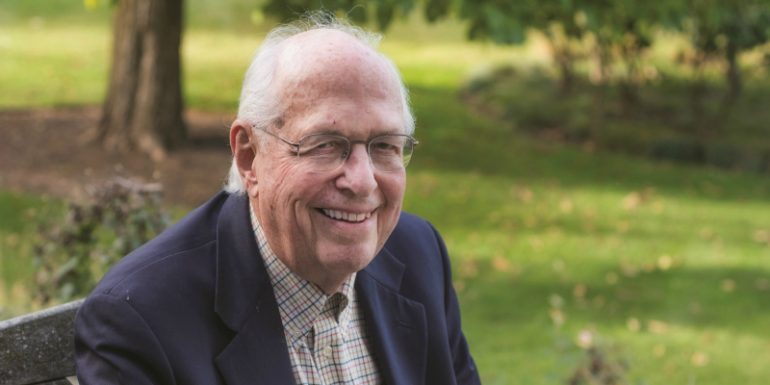By John Halverson
No map. No GPS. John Notz does not need any help navigating the roads around Geneva Lake. He is like the character in John Cheever’s The Swimmer, who traveled from one estate owner’s pool to another using “cartographer’s eyes.”
As he drives, Notz greets gardeners and estate owners by their first names and weaves through properties that few of us get to see with the access afforded one of the area’s most knowledgeable resident-explorers.
As he talks, you can see him thumbing through file cabinets of his brain, evoking a favorite architect or landscape designer. Notz’s voice rises with excitement as he drives through an estate that has been landscaped with native plantings. “It looks its best when the daffodils come out in the spring,” he says.
Along the way he bemoans homes that once were, but are now reduced to what he calls “archeological remains.”
He wishes there had been more foresight, when looking at structures such as the Frank Lloyd Wright-built Hotel Geneva which was eventually replaced by Geneva Towers, or the old train station, which facilitated the migration to Lake Geneva in the years following the 1871 Chicago fire — the building that people had asked, “Can this be retrofitted into some other use, without damaging the aesthetic value of what remains?”
“For instance, if I were to have sought the preservation of Wright’s Hotel, I would have favored the simultaneous construction of the tower that Wright designed, but it was never built,” Notz says. “Thereby, I think one would have had a better chance to generate the funds necessary for its ongoing operation.”
DEEP TIES TO LAKE GENEVA
Notz, a man with insatiable curiosity, was born and raised in the Chicago area and practiced law there for much of his life.
He now splits his time between Chicago and an architect-designed home, a stone’s throw from the Lake Geneva Country Club of which he has participated in writing a centennial history, and where he can be found, many weekend mornings, reading a newspaper.
Notz’s home is not as grand as some of the lakeshore estates, but it is large enough for his children and grandchildren and, with its sunroom and a study filled with books and papers, it suits him.
His guest is served coffee and a cookie, provided by his wife Janis, whom he met at a cocktail party when she had just graduated from college and Notz was a young lawyer.
Notz, first, spent his summers on Geneva Lake in a house on the grounds of what is now the Black Point Historic Site, one of the area’s go-to tourist attractions. On our road trip, he drove past the house. It is more modern and less auspicious than the estate itself, which was built for the family of Conrad Seipp, the Chicago brewer.
But Notz’s roots in the area go much further back than his stay on Black Point.
One of his great grandfathers, Edward Uihlein, built what became known as Forest Glen. On our vehicular trek around the lake, Notz drove through the remains of the estate, which was located between Williams Bay and Fontana and subdivided after Uihlein’s death.
Some vestiges of the old landscape, its streams and ponds, designed by Jens Jensen, one of Notz’s favorite landscape architects, can be still seen by his experienced eye.
Notz learned more about Uihlein when he found a memoir of his, written about 1920, and one that his mother had written, about 1950. “I wanted to see if he was the God that she thought he was,” he says. “And it turned out that he was a very fine man, but, like all of us, he had his warts.”
Notz has an old photograph showing Uihlein standing next to a long-gone Scandinavian hut within his estate as well as a plat of the entire acreage, discovered on the wall of a local friend, which shows where a golf course was contemplated for a part of the land.
EMERGING CURIOISITY
Now 85, Notz grew up in an era when reading was still in vogue. He feasted on the adventures of Horatio Hornblower and Alexandre Dumas’ Three Musketeers.
And, like other children of that era, he was allowed to explore. “I was expected to get out of the house,” Notz says. “‘Make sure that you are home in time for dinner!’ were the last words that we heard, day after day.”
Once off to college, he majored in theoretical mathematics, “only to find that, being good at dealing with numbers was not a road to mastery of theoretical mathematics,” he says. That his roommate became a graduate student of Albert Einstein, meant Notz was in fast company.
Late in his college days, Notz selected a course in American history, and a die was cast, when he had a professor who was an encouraging mentor. “It was when he gave me a top grade for an essay that I wrote, one about my father’s failed effort to join one of the U.S. military services in the 1930s, which my father attributed to anti-German attitudes of the men who interviewed him, I realized that I could write, persuasively, which, of course, is necessary for any lawyer’s career.”
After law school, Notz received a commission in the Air Force, spending time in Korea and Japan, just after the active fighting of the Korean War. The experience changed him, he says. “In short, I grew up. I had been born and raised with at least a silver-plated spoon in my mouth. Korea, right after the active fighting stopped, was a Third World Country,” he says. “And the Japanese had been able to do little more than climb out of their WWII pit.”
On his way home, he traveled to India, Saudi Arabia, Greece and Scandinavia, with a few side trips, “as long as my next stop was to the West of where I started that day’s flight.”
When he started practicing law, relationship-building was encouraged and, in Notz’s case, as he had clients in the architecture and planning professions, he took time to establish his interest in architectural history.
His interests blossomed as he became part of Chicago Literary Club and other organizations that extended beyond law.
Despite his segue into architecture and history, Notz does not begrudge the fact that he became a lawyer. “Academia has a structure and a pecking order that, in time, would have caused me great frustration,” he says. “The practice of law can have all the flexibility that one might want. However, researching the lives of people is far more interesting than trying to find useful legal rules. Both in the practice of law and in the search for biographical information, one finds really interesting people. It is, really, a matter of keeping one’s eyes and ears open.”
AREA’S HISTORY HAS INTRIGUED HIM
Notz’s interests have taken him in many directions at the lake. He has been active in the governance and the growth of the Black Point Historic Site, the Geneva Lake Conservancy, the history of Lake Geneva’s Oak Hill Cemetery and in activities of Horticultural Hall and of the Lake Geneva Museum.
He has the freedom not afforded the academic, who must publish to survive, “I publish when my research satisfied my curiosity, and I believe that others could be interested in what I have figured out,” he says.
“Because I do not have a trained eye, my attention is drawn, less, to the architecture, than to the interpersonal relationship between the architect and the client, which tends to mean that I am investing my effort in residential projects,” he says. “My focus on the success of a design is, “How well does the result of this design meet the needs of the client?”
Notz says that he admires architects “that the general public has been led to ignore,” like Henry Lord Gay and Robert Closson Spencer, Jr. Gay designed Stone Manor, the lake’s largest building. Robert Closson Spencer, Jr., was the architect for the Lake Geneva Country Club.
“Probably my investment of time in both of them is over, but it is clear that I will be spending more time on William Le Baron Jenney and John Olmsted, eldest son of Frederick Law Olmsted.” Jenney was the architect of what is now called the Landmark Center in Lake Geneva. John Olmsted designed the landscapes for several estates on Geneva Lake’s north shore as well as the grounds of Yerkes Observatory.
On the list of his most admired people is Charles R. Crane, whose father owned the Jerseyhurst Estate on the north shore of Geneva Lake and who was the client of several remarkable architects — Louis Sullivan, Purcell & Elmslie, Holabird & Roche and Shepley, Rutan & Coolidge — in short, a remarkable consumer of architectural services.
Crane, originally, a wealthy American businessman and, later, a noted expert on Arab culture, traveled broadly, especially in Eastern Europe and the Middle East.
Notz says, “How much I could learn, following him around the world!”





